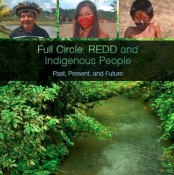Full Circle: REDD and Indigenous People Past, Present, and Future
Do you find REDD confusing, opaque, and obtuse? Do you wonder where it came from, how it evolved, and how it impacts indigenous people? If so, feel free to check out our emerging series on "Indigenous REDD" – or download a booklet containing our year-to-date coverage of this fascinating subject.

8 June 2015 | BONN | Germany | By now, most of us know that REDD stands for “Reducing Emissions from Deforestation and Degradation”, and that it generally uses carbon finance to save endangered forests.
But how does it work, and where did it come from – and what is the new “Indigenous REDD” initiative being spearheaded by the Latin American indigenous federation COICA (Coordinadora de las Organizaciones Indgenas de la Cuenca Amaz³nica)?
To answer these questions, we’re rolling out a series of easy-to-read articles focused on “Indigenous REDD”. Written in plain English for a general audience, these stories should bring you far enough into the weeds to understand the issues without getting in over your head – and they’ll provide a solid foundation for understanding our coverage as it unfolds between now and the year-end climate talks in Paris.
If you’d like to keep up on this series as it unfolds, please subscribe to the Ecosystem Marketplace eNewsletter by following this link. Subscribe to the Marketplace eNewsletter to receive a monthly summary of all Ecosystem Marketplace original content, or to the Forest Carbon Newsletter to receive our forest-related contentent, as well as content aggregated from other sources.
If you only want to receive the stories relevant to our Indigenous REDD series, send an e-mail to Steve Zwick at [email protected].
Here, meanwhile, are the stories we’ve published so far. Scroll down to the bottom for the booklet.
REDD Dawn: The Birth of Forest Carbon looks back at the genesis of REDD, which was conceived in 1988 by the World Resources Institute. It offers a brief introduction to the science of carbon accounting and an overview of REDD within the climate talks.
Indigenous People Explore Many Shades of REDD looks at how REDD has evolved on indigenous territories to-date, and how indigenous leaders believe it must change to truly deliver on its potential.
Choc³-Dari©n: What Projects Can – and Cannot – Achieve offers a deep dive into a project developed by the Afro-Colombian Tolo River People – and a primer on how REDD plays out on the ground.
Indigenous Life Plans and Carbon Finance: Two Sides of the Same Coin? examines the symbiotic relationship between indigenous “Life Plans” and REDD.
The Surui Forest Carbon Project: Lifeline For A Life Plan offers a detailed glimpse inside a pioneering indigenous project built on an indigenous Life Plan. Initially posted in 2013, it’s a bit dated, but still a good read.
Jurisdictional REDD: Long Deferred, Soon Delivered examines the state of “jurisdictional” REDD programs – government-to-government programs that are designed to reduce deforestation across an entire state or country.
REDD+ And Green Supply Chains: The Yin And Yang Of Saving Forests examines role that REDD finance can play in helping to purge deforestation from corporate supply-chains.
Click here to download Full Circle: REDD and Indigenous People – Past, Present, and Future, which is a PDF containing several of these stories.
Please see our Reprint Guidelines for details on republishing our articles.

